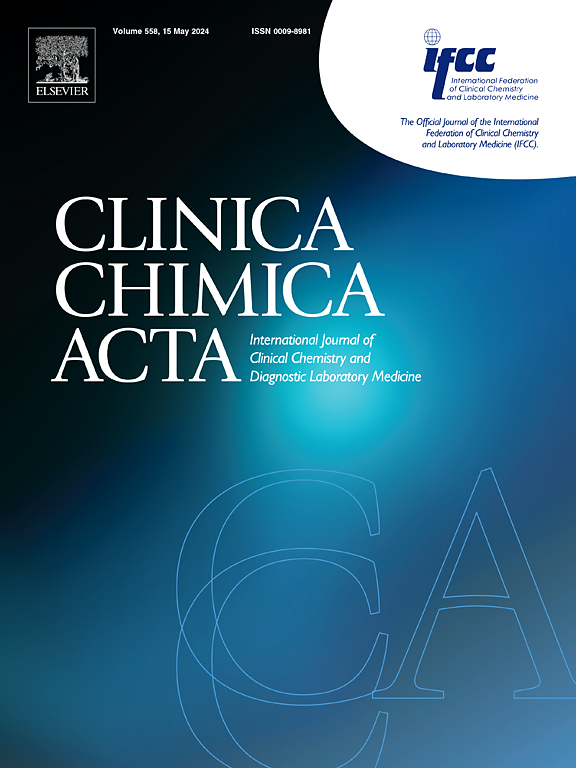乙基葡糖苷和可卡因作为酒精消费的毛发标记物的评价。
IF 2.9
3区 医学
Q2 MEDICAL LABORATORY TECHNOLOGY
引用次数: 0
摘要
背景和目的:就行为和器官损害而言,同时使用酒精和可卡因是一种已知的有害状况。这种情况的鉴定需要使用客观的生物标志物,如头发乙基葡萄糖醛酸盐(hEtG)和头发可可烯(hCE)。本研究的目的是调查它们在一组可卡因使用者中的存在及其可能的相互关系,以评估这两种分析物在酒精摄入回顾性调查中所提供的不同潜力。材料和方法:209个头发样本,以前收集可卡因使用者在重新颁发驾驶执照的背景下,分析了CE和EtG的存在。结果:在108例hCE检测阳性的个体中,只有57例hEtG也呈阳性(52.8% %)(超过我们的定量限制,即前者为0.05 ng/mg,后者为3 pg/ mg)。相反,在101例hCE阴性的样本中,63例hEtG阳性(62.4 %)。结论:观察到的结果强调了在提高诊断敏感性方面,综合使用两种代谢物作为基于酒精毛发标记物的可靠调查策略的优势。本文章由计算机程序翻译,如有差异,请以英文原文为准。
Evaluation of ethylglucuronide and cocaethylene as hair markers of alcohol consumption
Background and aims
The concurrent use of alcohol and cocaine is known to be a harmful condition in terms of behaviour and organ damage. The identification of this condition requires the use of objective biomarkers, such as hair ethylglucuronide (hEtG) and hair cocaethylene (hCE).
The aim of the present work was to investigate their presence and their possible mutual relationship in a group of cocaine users to evaluate the different potentials offered by the two analytes in the retrospective investigation of alcohol intake.
Materials and methods
209 hair specimens, previously collected from cocaine users in the context of re-issuing of the driving license, were analysed for the presence of CE and EtG.
Results
Out of the 108 individuals who tested positive for hCE, only 57 resulted also positive for hEtG (52.8 %) (above our limit of quantification, i.e. 0.05 ng/mg for the former and 3 pg/ mg for the latter). Conversely, in a group of 101 hCE negative, 63 samples tested hEtG positive (62.4 %).
Conclusions
the observed findings highlighted the advantage, in terms of improvement of diagnostic sensitivity, of an integrated use of the two metabolites for a reliable investigation strategy based on alcohol hair markers.
求助全文
通过发布文献求助,成功后即可免费获取论文全文。
去求助
来源期刊

Clinica Chimica Acta
医学-医学实验技术
CiteScore
10.10
自引率
2.00%
发文量
1268
审稿时长
23 days
期刊介绍:
The Official Journal of the International Federation of Clinical Chemistry and Laboratory Medicine (IFCC)
Clinica Chimica Acta is a high-quality journal which publishes original Research Communications in the field of clinical chemistry and laboratory medicine, defined as the diagnostic application of chemistry, biochemistry, immunochemistry, biochemical aspects of hematology, toxicology, and molecular biology to the study of human disease in body fluids and cells.
The objective of the journal is to publish novel information leading to a better understanding of biological mechanisms of human diseases, their prevention, diagnosis, and patient management. Reports of an applied clinical character are also welcome. Papers concerned with normal metabolic processes or with constituents of normal cells or body fluids, such as reports of experimental or clinical studies in animals, are only considered when they are clearly and directly relevant to human disease. Evaluation of commercial products have a low priority for publication, unless they are novel or represent a technological breakthrough. Studies dealing with effects of drugs and natural products and studies dealing with the redox status in various diseases are not within the journal''s scope. Development and evaluation of novel analytical methodologies where applicable to diagnostic clinical chemistry and laboratory medicine, including point-of-care testing, and topics on laboratory management and informatics will also be considered. Studies focused on emerging diagnostic technologies and (big) data analysis procedures including digitalization, mobile Health, and artificial Intelligence applied to Laboratory Medicine are also of interest.
 求助内容:
求助内容: 应助结果提醒方式:
应助结果提醒方式:


